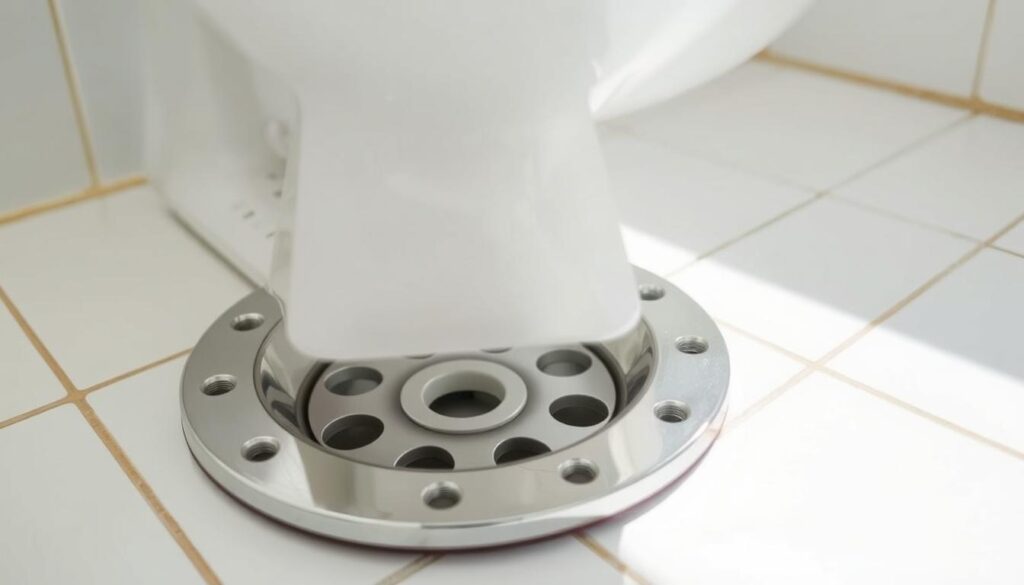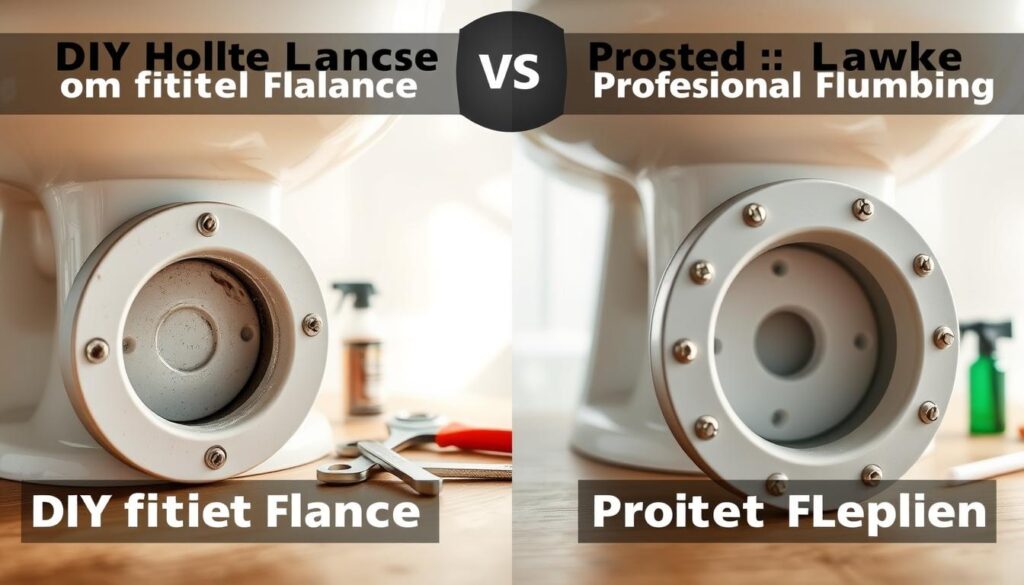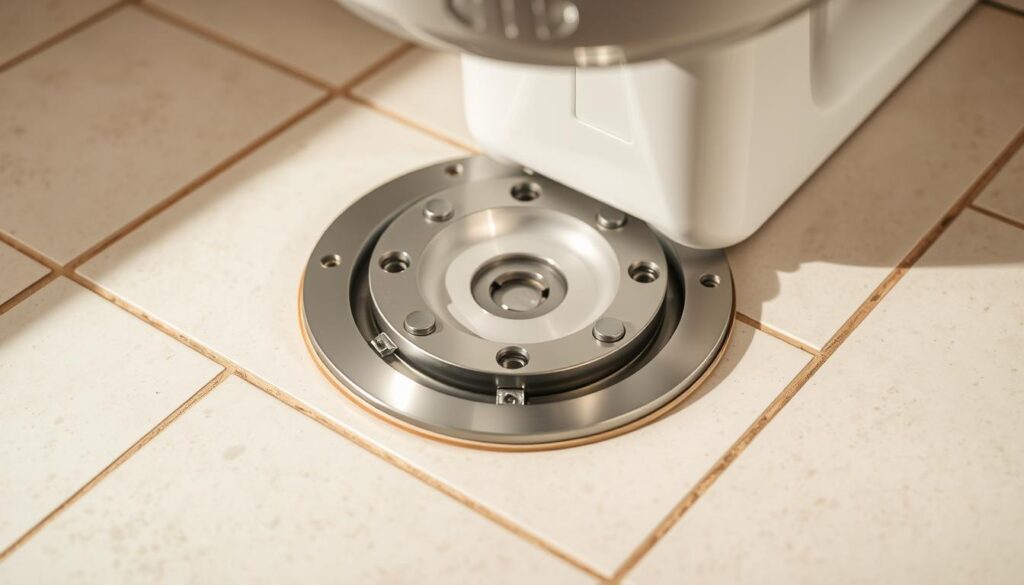A toilet flange is key to keeping the toilet firmly on the floor. It stops leaks and other problems. The cost to replace it depends on the flange type and how it’s installed.
Fixing a bad flange is vital for a clean and safe bathroom. Knowing the cost of replacement is important for homeowners. It helps them understand what affects the price.

Introduction to Toilet Flange Replacement
The cost to replace a toilet flange can change. But, a secure and leak-free toilet is worth it. It saves money in the long run.
Key Takeaways
- The cost of replacing a toilet flange can vary depending on the type of flange and installation method, affecting the toilet flange replacement cost.
- Replacing a damaged or faulty flange is essential to maintain a safe and healthy bathroom environment.
- The toilet flange replacement cost can be a significant concern for many homeowners.
- Understanding the factors that influence the cost of replacing a toilet flange can help homeowners make informed decisions.
- A secure and leak-free toilet installation can help reduce the overall toilet flange replacement cost.
- Regular maintenance can help extend the life of the toilet flange and reduce the need for replacement.
Understanding Toilet Flange Replacement Costs
When it comes to toilet flange installation, costs can vary. Several factors influence the price. These include the type of toilet flange materials, the installation’s complexity, and the toilet’s location. Let’s look at the average costs for materials and professional installation fees.
A typical toilet flange installation can cost between $50 and $200. This depends on the flange type and materials. For instance, a PVC flange is cheaper than a stainless steel or cast iron one. Also, the quality and brand of the toilet flange materials affect the price.
When estimating toilet flange installation costs, consider a few things:
- Type of toilet and flange needed
- Material of the floor and surrounding area
- Accessibility of the toilet location
These factors can change the installation cost. They should be thought of when planning a toilet flange replacement.
Signs You Need a Toilet Flange Replacement
Knowing when to replace a toilet flange is key for a DIY toilet flange replacement. A flange connects the toilet to the floor. If it fails, you might see water leaks, floor damage, and bad smells.
Look out for water leaks, a toilet that wobbles, mineral buildup, rust, or corrosion on the flange, and bad smells. If you see these signs, fix it fast to avoid more damage and expensive fixes.
Here are some key signs to look out for:
- Water leaks around the base of the toilet
- A loose or rocking toilet
- Mineral deposits, rust, or corrosion on the flange
- A foul odor emanating from the toilet
Spotting these signs early helps you replace the flange right. This keeps your toilet and floor safe. Always follow the right steps and be careful when working with plumbing.
Types of Toilet Flanges and Their Prices
Choosing the right toilet flange is key when you need to replace one. There are many types, each with its own benefits and drawbacks. The cost also varies based on the material and quality. Knowing about the different types helps homeowners make a smart choice.
PVC flanges are the most common and affordable. They are durable and easy to install. Other options include cast iron, stainless steel, and copper, each with its own features and prices.
PVC Flanges
PVC flanges are the cheapest and most available. They are simple to put in and keep up, making them a favorite among homeowners.
Cast Iron Flanges
Cast iron flanges last longer than PVC and resist corrosion well. They can handle high water pressure, perfect for older homes.
Stainless Steel Flanges
Stainless steel flanges resist corrosion and can handle extreme temperatures. They are more durable than PVC and last a long time with care.
Copper Flanges
Copper flanges are the priciest but most durable. They resist corrosion and high water pressure, ideal for complex plumbing systems.
In summary, the right toilet flange depends on your needs and budget. By looking at the different types and their costs, you can choose wisely. This ensures a successful replacement.
Required Tools and Materials for Replacement
For a professional toilet flange installation, you need the right tools and materials. You’ll need a wrench, pliers, and a screwdriver. Also, a new flange, wax ring, and other materials as the manufacturer suggests.
Here’s what you’ll need for a professional installation:
- New toilet flange
- Wax ring
- Flange bolts
- Flange gasket
These materials are usually included in the overall cost of the installation. But if you’re doing it yourself, you’ll have to buy them. It’s important to choose quality materials for a good seal and to avoid leaks.
For DIY, you’ll need specific tools. A professional plumber will have these, but you might not. Here’s what you’ll need:
- Wrench
- Pliers
- Screwdriver
- Putty knife
A professional toilet flange installation needs the right tools and materials. With quality materials and the right tools, you can ensure a good seal and avoid leaks.
How Much Is It to Replace a Toilet Flange Professionally?
Hiring a professional to replace a toilet flange is often the best choice. The cost can change based on several things, like where you live and the plumber’s rates. On average, a licensed plumber might charge between $100 to $300 per hour. The total cost can be anywhere from $200 to $1,000, depending on how complex the job is.
The cost also depends on the type of flange and materials used. Regional price variations can affect the total cost too. To get a precise estimate, it’s best to talk to a licensed plumber. They can check the situation and give you a detailed quote.
Licensed Plumber Rates
- Average hourly rate: $100-$300
- Total cost: $200-$1,000
- Factors affecting cost: complexity of the job, location, and plumber’s experience
Emergency Service Costs
If it’s an emergency, the cost might be higher because it’s urgent. It’s important to find a reliable plumber who offers emergency services at a fair price.
Regional Price Variations
The cost of installing a toilet flange can vary a lot by region. It’s key to look around and compare prices from different plumbers in your area. This way, you can find the best deal.
DIY vs Professional Installation: Cost Comparison
Homeowners face a choice when replacing a toilet flange: DIY or professional installation. DIY costs range from $50 to $200, based on materials and tools. Professional installation can cost between $200 to $1,000.
DIY costs include the flange, wax ring, and tools. Professional installation covers labor, materials, and permits.
Here is a comparison of the costs involved in DIY and professional installation:
- DIY toilet flange replacement: $50 to $200
- Professional toilet flange installation: $200 to $1,000

DIY can save on labor costs but might not be for everyone. Professional installation offers a warranty and peace of mind but costs more. The choice depends on comfort with DIY and budget.
Potential Complications and Additional Costs
Replacing a toilet flange can lead to unexpected issues, which can increase the cost. The materials used for the flange play a big role in this. For example, flanges made from lower-quality materials might damage the subfloor or need pipe repairs.
Some common problems that may occur include:
- Subfloor damage: This can happen if the old flange is not removed carefully, causing damage to the surrounding subfloor.
- Pipe repairs: If the pipes are old or corroded, they may need to be repaired or replaced, adding to the overall cost.
- Wax ring replacement: A new wax ring may be required to ensure a proper seal between the toilet and the flange, which can add to the cost.
It’s important to think about these possible problems when planning to replace a toilet flange. Choosing the right materials and types can help avoid these issues. This ensures a successful replacement.
Time Requirements for Flange Replacement
Replacing a toilet flange requires careful planning, especially when it comes to time. The toilet flange replacement cost can change based on the job’s complexity and the person’s skill level. On average, a DIY job might take 2 to 4 hours. A professional might finish it in 1 to 3 hours.
The time needed also depends on the flange type. For instance, a PVC flange is often quicker to install than a cast iron one. Here are some general time frames to keep in mind:
- DIY replacement: 2-4 hours
- Professional replacement: 1-3 hours
When deciding between DIY or hiring a pro, think about the toilet flange replacement cost. While hiring a pro might cost more upfront, it can save you time and money. It ensures the job is done right and efficiently.
Insurance and Warranty Considerations
When you’re thinking about installing a toilet flange, insurance and warranties are key. Homeowners should know what their homeowner’s insurance covers. It might help with damages or repairs to the flange. Also, warranties from the manufacturer can protect against defects or issues with the flange, giving you peace of mind.
Professional installation can also come with guarantees. These guarantees ensure the job is done right and with quality materials. It’s important to understand the terms of these warranties and guarantees. This helps you make the best choices.
- Coverage for toilet flange materials and labor costs
- Duration of the warranty or guarantee
- Conditions for filing a claim
By looking at these points and choosing a trusted installer, you can have a successful installation. This meets your needs and stays within your budget.

Maintenance Tips to Extend Flange Life
Regular maintenance is key to keeping your toilet flange in good shape. Always check for leaks, as a small one can quickly become a big issue. When you replace the flange yourself, make sure it’s securely attached to the floor. This helps prevent leaks in the future.
Cleaning the flange regularly is another important step. Use a soft brush and mild soap to remove debris or mineral buildup. Using a flange with a built-in wax ring can also help prevent leaks and cut down on maintenance. Knowing the different toilet flange types can help you understand their maintenance needs.
Here are some more tips to keep your toilet flange in top condition:
- Check the flange for any signs of damage or wear
- Ensure the toilet is properly secured to the floor
- Use a toilet flange with a built-in wax ring
- Regularly inspect the flange for any mineral buildup or debris
By following these simple tips, you can extend your toilet flange’s life and avoid future problems. Regular maintenance is crucial for a long-lasting flange. It saves you money and hassle, whether you do it yourself or hire a professional.
When to Schedule Your Replacement
Knowing when to replace your toilet flange is key to avoiding emergencies and expensive fixes. A professional toilet flange installation can prevent future issues. But, timing is everything. If your toilet leaks or you see water damage, it’s an emergency that needs quick action.
Such emergencies might make the toilet flange replacement cost go up. But, if you plan to get a professional toilet flange installation as part of upkeep, you can dodge these extra costs. Here are times when you should think about getting a replacement:
- Emergency situations: If you see water leaking from your toilet or damage around it, call a pro for a toilet flange replacement.
- Planned maintenance: Regular checks on your toilet flange and a replacement as part of upkeep can stop future issues. This also cuts down the toilet flange replacement cost.
Being proactive and scheduling a professional toilet flange installation at the right time can save you money. It ensures your toilet works right. Always think about the toilet flange replacement cost and plan to avoid surprise expenses.
Conclusion
Starting your toilet flange installation project is a big step. It takes time and effort, but it’s worth it. Knowing about the materials, costs, and steps helps your toilet work right and keeps your home in great shape.
Deciding to do it yourself or get a plumber is up to you. But knowing what to do is key to saving money and time. This guide will help you through the process, making your bathroom a worry-free place for years.
Looking after your home’s plumbing is important. Fixing toilet flange problems keeps your home’s value up and your family safe. So, go ahead and replace that flange when it’s needed.
FAQ
How much does it cost to replace a toilet flange?
Replacing a toilet flange can cost between $50 to $200. This depends on the flange type and materials. Adding professional installation can increase the cost by $100 to $300.
What are the signs that a toilet flange needs to be replaced?
Signs include water leaks, a rocking toilet, mineral buildup, rust, or a foul smell. These indicate the need for a new flange.
What types of toilet flanges are available and how much do they cost?
You can find PVC, cast iron, stainless steel, and copper flanges. PVC is the most affordable. Cast iron is more durable but pricier.
What tools and materials are required to replace a toilet flange?
You’ll need a wrench, pliers, and screwdriver. Also, a new flange, wax ring, and any extra materials the manufacturer suggests.
How much does it cost to have a professional replace a toilet flange?
Professional costs range from $200 to $1,000. This depends on location, plumber’s rates, and emergency fees. Plumbers charge $100 to $300 per hour.
What are the potential complications and additional costs involved in replacing a toilet flange?
Complications can include subfloor damage, pipe repairs, or needing a new wax ring. These can increase the overall cost.
How long does it take to replace a toilet flange?
DIY replacement takes 2 to 4 hours. A professional can do it in 1 to 3 hours, depending on the job’s complexity.
What insurance and warranty considerations should be taken into account when replacing a toilet flange?
Check your homeowner’s insurance and manufacturer warranties. Professional installation guarantees offer extra protection against future issues.
How can I extend the life of my toilet flange?
Regular maintenance is key. Check for leaks, clean the flange, and ensure the toilet is secure. Using a flange with a built-in wax ring helps prevent leaks.
When should I schedule a toilet flange replacement?
Schedule a replacement during planned maintenance to avoid emergencies. Emergency situations need immediate action to prevent costly repairs.
